Innovations for Educational Facility Design
Energy Use and Efficiency
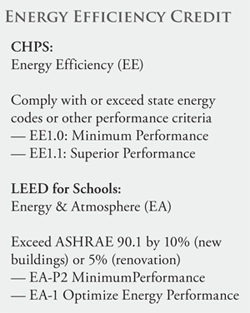 Used properly, daylighting also reduces building energy loads by replacing electrical lighting, adding controlled thermal gain, and feeding solar-powered systems. Energy efficiency is a central tenet of the certifications. In California, facilities meeting CHPS must meet or exceed the 2008 version of the state's Title 24, Section 6 energy code. In Massachusetts, the state's "Stretch Energy Code," defined as 20% more efficient than a national baseline, serves as the model. LEED for Schools calls for either whole-building energy simulations per ANSI/ASHRAE/IESNA Standard 90.1-2007, or prescriptive paths based on ASHRAE's Advanced Energy Design Guides or the Vancouver, Wash.-based New Buildings Institute's Advanced Buildings Core Performance Guide.
Used properly, daylighting also reduces building energy loads by replacing electrical lighting, adding controlled thermal gain, and feeding solar-powered systems. Energy efficiency is a central tenet of the certifications. In California, facilities meeting CHPS must meet or exceed the 2008 version of the state's Title 24, Section 6 energy code. In Massachusetts, the state's "Stretch Energy Code," defined as 20% more efficient than a national baseline, serves as the model. LEED for Schools calls for either whole-building energy simulations per ANSI/ASHRAE/IESNA Standard 90.1-2007, or prescriptive paths based on ASHRAE's Advanced Energy Design Guides or the Vancouver, Wash.-based New Buildings Institute's Advanced Buildings Core Performance Guide.
Increasingly, architects focus on enclosure design to meet these benchmarks, says Rick Brow, director of marketing for CENTRIA, a Moon Township, Pa.-based producer of metal panels that analyzed various cladding and enclosure systems. "Many project teams are using thermal modeling to understand the performance of window-wall interfaces, panel attachments or other attributes," he explains. "A break in the enclosure's air/vapor barrier or a thermal bridge can cause moisture intrusion, condensation or thermal conductivity. It's better to test that performance in the lab, not in the field."
 |
Designed by architect SRG Partnership, the Chemeketa Community College's 74,000-square-foot project revamped the facilities that house space and equipment for nursing, dental hygiene and pharmacy technology students, with a durable metal-panel cladding system incorporating an insulated composite back-up panel. Photo courtesy of CENTRIA |
 |
Building envelope insulation, including continuous exterior insulation, is more important than ever for educational facilities, as shown in this cladding schematic. Image courtesy of Roxul Inc. |
Another impetus has been the growing use of air barriers and continuous insulation (ci), which are increasingly called for by local jurisdictions as well as model building codes such as IBC and IECC. "Continuous insulation is in the codes now, so new and renovated facilities need to have it installed exterior to the building structure or framing," says Cary Robertson, a civil engineer and envelope specifications expert who is U.S. national sales manager for Roxul, the Milton, Ontario-based stone wool insulation manufacturer. "It's accompanied by new questions, such as the fire ratings of these wall assemblies or the need for vapor permeability to maximize the drying potential of walls prone to condensation or moisture migration. Another key issue is that some insulation materials may dissipate in R-value over the long-term."
Within the walls of educational facilities, according to the U.S. Environmental Protection Agency (EPA), energy consumption is driven largely by mechanical systems. In addition to optimized HVAC design, institutional owners are looking for more use of renewable power to offset these costs. "Based on the requirements of LEED for Schools – especially the Gold or Platinum certifications – there's a strong incentive to incorporate nonpolluting and renewable energy sources such as geothermal," says Tony Landers, a former HVAC systems designer who is now director of marketing for Oklahoma City's ClimateMaster, which specializes in water-source heat pumps. Landers points to a nearby high school, Metro Career Academy – the first LEED Gold of its kind in Oklahoma – as an example using underground thermal sources.
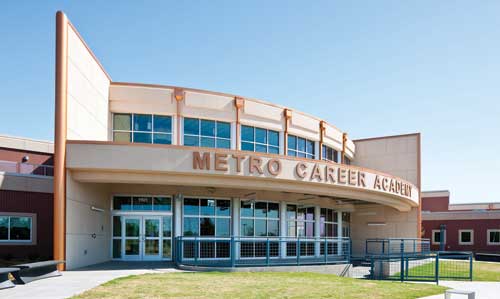 |
A high school for at-risk students, Metro Career Academy – the first LEED Gold of its kind in Oklahoma – uses underground thermal sources to reduce HVAC operating costs. Photo courtesy of ClimateMaster |
Another factor is the increased heat and energy draw from plug loads, which account for up to 25 percent of the total electricity consumed by schools, according to the National Energy Education Development (NEED) Project, Manassas, Va. This may increase, even as architects see wireless communications and tablet technology revolutionizing how students collaborate and present their work, says Joshua Zinder, AIA, LEED AP, principal of Princeton, N.J.-based Joshua Zinder Architecture + Design. "Yet while the technology is new, their operational and pedagogical characteristics date back to the one-room school house, where tablets and lap boards were standard. Yes, you can do more with today's tablets, but in terms of the effect on organizing classroom space, there are important similarities."
 |
Increasingly, universities and K-12 schools are using ceramic tile and natural stone finishes because of their durability, low toxicity and favorable life-cycle performance. The University of Florida provides an example. Photo courtesy of Florida Tile |
Materials and Resource Conservation
For these learning tools as much as for novel building materials and finish choices, their effect on educational environments is increasingly viewed through the lens of life cycle analysis or assessment (LCA), say experts in innovative schools design. This shift in emphasis appears in LEED 2009, which employs LCA in its credit weighting, while CHPS generally "rewards the use of materials and products that have undergone life-cycle analysis," specifically in its Credit 6, Sustainable Materials – LCIA. LEED 2009 uses EPA's TRACI1 environmental impact categories – including LCA, industrial ecology and pollution prevention – to weigh credits.
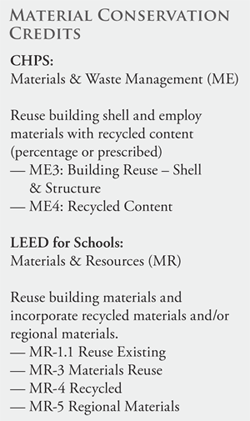 In product evaluations for educational facilities, LCA techniques help answer questions about toxicity, total greenhouse-gas emissions and durability. It also reduces the sole focus on first cost, instead favoring the life-cycle cost benefits of highly durable materials such as metal, stone and glass block, which have low maintenance needs and consistent long-term performance. "The main advantage of metal surfaces is longevity," says Blake Batkoff, director of marketing and sales with Petersen Aluminum Corp., Elk Grove, Ill. "Once a metal system is installed as roofing or wall cladding, it should be the last application for a school facility."
In product evaluations for educational facilities, LCA techniques help answer questions about toxicity, total greenhouse-gas emissions and durability. It also reduces the sole focus on first cost, instead favoring the life-cycle cost benefits of highly durable materials such as metal, stone and glass block, which have low maintenance needs and consistent long-term performance. "The main advantage of metal surfaces is longevity," says Blake Batkoff, director of marketing and sales with Petersen Aluminum Corp., Elk Grove, Ill. "Once a metal system is installed as roofing or wall cladding, it should be the last application for a school facility."
Related benefits for products with good LCA results include minimal maintenance, low embodied energy, and options for recycling or reuse. Natural materials may also benefit student health. "Natural stone and ceramic tile are natural choices for the walls and floors of K-12 and higher-education buildings because of their inherent antimicrobial and cleaning properties as well as favorable LCA and life-cycle costs. These are highly durable materials," adds Sean Cilona, director of marketing with Lexington, Ky.-based manufacturer, Florida Tile.
"Life-cycle costing is a key improvement to all types of development for our clients and the public in general," says David M. Sikorski, P.E., a managing director with AECOM's Alternative Delivery Group in New York City. "In the not-too-distant past most projects were low bid. While that may have saved the client money up front, it probably did not over the life of the facility. Now we consider life-cycle in design and maintenance costs, and we're producing better results."
Notice
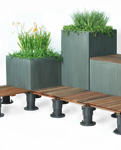
www.BisonIP.com
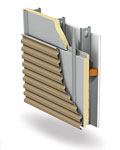
www.buildbetterwalls.com

www.price-hvac.com/sustainable
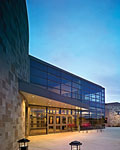
www.sunguardglass.com
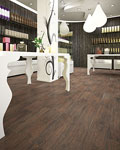
www.floridatile.com
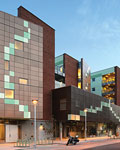
www.dri-design.com
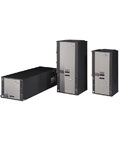
www.climatemaster.com
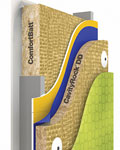
www.roxul.com
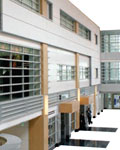
www.safti.com
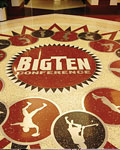
www.ntma.com
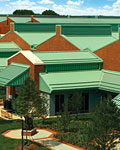
www.PAC-CLAD.com
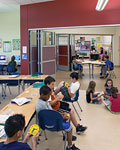
www.Nanawall.com









